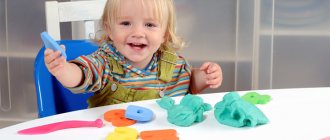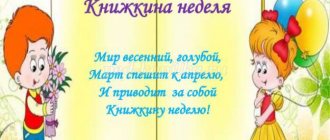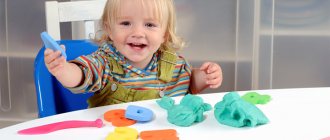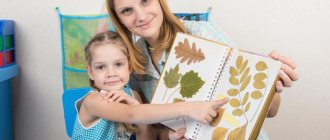MAGAZINE Preschooler.RF
Short-term project “Through the pages of Russian folk tales” in a preparatory school group.Project type: educational and creative.
Project duration: short-term project, 1 week.
Project participants: children of the preparatory group, teacher.
Children's age: 6-7 years.
Educational areas: speech development, artistic and aesthetic development, cognitive development, physical development, social and communicative development.
Relevance: Books are of great importance in a person’s life. A child’s strong interest in reading and reading habit are formed in the family. While the child is small, parents read books to him, and as soon as the baby learns to read on his own, they breathe a sigh of relief. It's no secret that many children grow up without loving a book. Most often, children read comics, sticker magazines, watch videos, play computer games, but the art book remains untouched and loses its importance in the formation of artistic taste. Children and their parents spend most of their free time watching TV or a computer; as a result, the reading process slows down and interest in the book is lost. Reading fiction is of great importance for the all-round development of a child. Their success in learning depends on how children understand the content of what they read, how they can read fluently and expressively, analyze the actions of characters, and draw conclusions.
Once a child begins to become interested in a book, he will find himself in a completely different world - fascinating, colorful, interesting, which will give him many discoveries and finds. The love of reading and books is a love for life, so it is very important to encourage a preschooler’s first successes in reading and storytelling, and to stimulate his interest in words and good works.
A baby book made by preschoolers will increase interest in fiction, give an understanding of the importance of books in a person’s life and increase children’s self-esteem for their work.
A baby book is both entertainment and a pastime with the child, as well as learning.
The most fertile soil, with unlimited developmental and educational opportunities, is the Russian folk tale.
Russian folk tales reveal to children the precision and expressiveness of the language, showing how rich their native speech is in humor, lively and figurative expressions. The amazing power of linguistic creativity of the Russian people has never manifested itself as clearly as in folk tales. Their inherent extraordinary simplicity, brightness, imagery, and ability to repeatedly reproduce the same speech forms and images make it possible to put forward fairy tales as a factor in the development of coherent speech in children.
Hypothesis: A fairy tale has an advantage over other educational techniques. This is a kind of moral code of the people, their heroics are, although imaginary, but examples of the true behavior of an honest person who knows how to stand up for his dignity.
A fairy tale plays a crucial role in the development of imagination - an ability without which neither the mental activity of a child during preschool and school education, nor any creative activity of an adult is possible. Fairy tales instill interest in reading fiction.
Difficulties in children developing coherent speech, the sequence of stories about the events of their lives, the ability to retell literary works, compiling stories based on a picture and a series of pictures, and compiling descriptive stories. Children's creative abilities are poorly developed.
Target:
To cultivate in children a love of books, as well as a love of Russian folk tales; develop in children a sustainable interest in fairy tales as a work of art; revealing children's creative abilities.
Tasks:
- To increase children's interest in independent reading activities.
- To develop the ability to plan the process of making a book - babies.
- Expand children's understanding of fairy tales.
- To develop in children the ability to independently select literature of interest.
- Development of fine motor skills of the hands.
- To develop imaginative thinking, imagination, and creative abilities in children.
- Foster feelings of friendship and collectivism.
- Foster a culture of speech.
- Foster love and respect for books.
- Education of aesthetic taste.
Planned results:
- Increasing the effectiveness of work on the development of coherent speech in children.
- Enriching children's vocabulary.
- Children’s use of elements of Russian folklore, comparisons, metaphors, epithets and other means of figurative expression in their speech.
- The ability to play didactic and printed board games, solve and compose your own riddles, solve crosswords and puzzles based on Russian folk tales.
- Application of acquired knowledge, skills and abilities in creative activities (creating a baby book).
Project product: Little book based on Russian folk tales: “Kolobok” , “Turnip” , “The Wolf and the Seven Little Goats” , “Zaykina’s Hut” , “Teremok” , “Masha and the Bear” , “The Fox with a Rolling Pin” , “Geese” swans" .
Expected results for the project:
- developing children's interest in Russian folk tales
- consolidation of the ability to apply one’s knowledge in conversation and coherent statements
- fostering a sense of friendship and collectivism
- get an emotional response from your work
- replenishing the book corner with handmade baby books.
Stage I “Preparatory”
- Studying literature on project activities.
- Preparation of methodological literature, illustrated books with Russian folk tales, illustrations based on the plots of Russian folk tales.
- Development of notes for joint activities, quiz scripts on the topic “What a miracle these fairy tales are!” .
- Enrichment of the developmental environment: in the book corner - the introduction of Russian folk tales, illustrated by various artists; illustrations, postcards depicting fairy tale characters as you study; in the speech zone - the introduction of didactic and board-printed games on the topic; production and gradual introduction of theaters (flat, tabletop, on sticks, on spoons, on cones, Bibabo, finger); masks in the playing area,
in fine arts - coloring books depicting plots and heroes of Russian folk tales, materials for creative works, reproductions of paintings based on Russian folk tales.
5. selection of visual and didactic material.
Stage II “Information and creative”
Cognitive development:
- SOD: “Russian folk tales” .
- FEMP (educational games): “Tsarevich Ivan saves Vasilisa the Wise” (labyrinth),
- Construction: “Build a castle for Helen the Beautiful” (builder); “Frog Princess” , “Firebird” , “Bunny” (origami).
Speech development:
1. SOD: Retelling the fairy tale “Fear has big eyes .
SOD: Storytelling based on a series of pictures “Fox-Sister and Wolf” .
SOD: Creative storytelling: . ”
2. Telling fairy tales using mnemonic tables.
3. Compilation of descriptive stories about heroes and magical objects of Russian folk tales. Children come up with riddles on the topic.
4. Didactic games: “What first, what then” , “What fairy tale did the hero (heroine) come from?” , “Which fairy tale is the magic thing from?” , “Choose an illustration for a fairy tale” , “Confusion” , “Add the picture and find out the fairy tale”
5. Reading fiction: “The Cockerel is the Golden Comb” (comparison with the plot of the fairy tale “The Cat, the Rooster and the Fox” ), “Geese-Swans” , “Sister Alyonushka and Brother Ivanushka” , “Sivka-Burka” and “Ivan the Tsarevich” and the Gray Wolf" (comparison of fairy tale plots), "At the behest of the pike" , "The Tale of Baba Yaga" , "Seven Simeons" , "Morozko" , "Snow Maiden" , "Finist - Clear Falcon" , "Flying Ship" , "Magic ring" .
Social and communicative development:
- Game-dramatization based on the Russian folk tale “Little Red Riding Hood” .
- Playing out plots from fairy tales: “The Wolf and the Fox” , “Cockerel – Golden Comb”
- Conversation: “What would you do if you had a magic wand?” .
- Guessing riddles.
- Memorizing rhymes and poems.
- Board and printed games: “Favorite fairy tales” ( “We play and learn” ), “My favorite fairy tales” ( “Umka” educational games - find out by the shadow), “Tales about animals” , “Fairy tales. Game on the road" (with chips), dice "Favorite fairy tales" , theater of fairy tales.
Physical development:
Outdoor games: “Geese and Swans” , “Golden Gate” , “Cat and Mouse” , physical exercise “Fairy Tales” ; finger gymnastics “Favorite Tales” , eye and breathing exercises.
Artistic and aesthetic development:
1. Examination of reproductions of paintings by V. Vasnetsov “Alyonushka” , “Ivan Tsarevich on the Gray Wolf” .
3. Drawing “Based on Russian folk tales” (watercolors, crayons, felt-tip pens).
4. Drawing with sand “Based on Russian folk tales” .
5. Applique “Decorate a sundress, a shirt-shirt for a Russian costume .
6. Modeling “My favorite heroes” .
8. DIY theater.
9. The teacher shows theaters based on fairy tales: “The Three Little Pigs” (shadow), “Swan Geese” (Tabletop), Teremok (planar).
10. Watching cartoons based on your favorite Russian folk tales.
11. Performance in the garden “Based on Russian folk tales” .
12. Music: selection of musical material for playing out the plots of fairy tales, Russian folk songs, round dances, musical folk games.
Collaboration between parents and children:
- Reading Russian folk tales suggested by the teacher at home.
- Compiling fairy tales in a new way, designing baby books.
Working with parents:
1. Consultation for parents “Parenting with a fairy tale .
Stage III “Final”
Project results:
- The group has created the necessary conditions for children to develop a holistic understanding of Russian folk culture.
- The children's horizons expanded and their vocabulary became more active.
- The children's speech became expressive and emotionally charged.
- Children play out the plots of familiar fairy tales with interest and pleasure, play different types of theaters, didactic and printed board games based on Russian folk tales.
- Children use the acquired knowledge, skills and abilities in their creative works.
- Parents actively participated in introducing children to Russian folk tales, performing creative work based on their stories, and making theaters.
Project product:
- Exhibition of children's creative works based on fairy tale plots (drawings, applications, sand painting, modeling).
- Children's books "Fairy tale in a new way" (children and parents).
- Theaters made by the hands of children, parents, teachers and their assistants.
- Quiz “What a miracle these fairy tales are!” (children and parents).
- Lapbook “Welcome to the Fairy Tale”
Result:
The children were interested in and close to the theme of the project, so the children took part in all the events with pleasure; love to listen to fairy tales performed by the teacher; enjoy looking at illustrations in books. In independent play activities, familiar fairy tales are played out with the help of toys and various types of theater; Some pupils come up with new, their own fairy tales. The children have become friendlier; come to each other's aid more often.
Thus, the work done during the project gave a positive result not only in the cognitive, speech, but also in the social development of children; and also contributed to the emergence of interest and desire among children to take part in the project “Through the Pages of Our Fairy Tales” ; brought the children and teachers of our group closer together.
Bibliography:
- Antipina E.A. Theatrical activities in kindergarten. -M., 2003.
- Zimina I. Theater and theatrical games in kindergarten // Preschool education, 2005. -No. 4.
- Kochkina N.A. Project method in preschool education: Methodological manual. - M.: Mozaika-Sintez, 2012.
- Lykova I.A. Visual activities in kindergarten. – M., Sfera, 2007
- Rumyantseva E.A. Projects in preschool educational institutions: practice of teaching children 3-7 years old. Volgograd: Teacher, 2014.
- Sorokina N.F. Playing puppet theater: Theatre-creativity-children . -M.: ARKTI, 2004.
- Ivanova Maria Petrovna
- Nikonova Tatyana Vasilievna
Teachers, State budgetary preschool educational institution kindergarten No. 11, Pushkinsky district, St. Petersburg
| Next > |
Project “Visiting a Fairy Tale”
- May 6, 2016
Conference “Project activity in an educational institution - 2016”
Nomination “Pedagogical project in a preschool institution”
“Thanks to a fairy tale, a child learns about the world not only with his mind, but also with his heart.” V.A. Sukhomlinsky
A fairy tale is a necessary element of a child’s spiritual life. Entering the world of miracles and magic, the child plunges into the depths of his soul. Fairy tales, introducing children to the circle of extraordinary events and transformations that occur with their heroes, express deep moral ideas. They teach kindness towards people, show high feelings and aspirations. Meeting children with fairy tale heroes will not leave them indifferent. As a result of empathy, the child acquires not only new knowledge, but also, most importantly, a new emotional attitude towards the environment: people, objects, phenomena. From fairy tales, children draw a lot of knowledge: their first ideas about time and space, about the connection between man and nature, the objective world.
The “Visiting a Fairy Tale” project is carried out as an exciting, playful, creative activity aimed at enhancing communication between children and adults. An integrated approach allows you to develop in unity the child’s speech, cognitive activity, creativity, communication skills, and emotional responsiveness.
The project is aimed at nurturing a love for fairy tales and developing the creative abilities of preschoolers through organizing joint activities between children and adults (parents, teachers).
Statement of the problem: nowadays, most children are brought up not on fairy tales, but on modern cartoons. Most parents don't have time to sit down with their child and read a book. Child psychologists consider this a big omission of adults in raising their children.
Data obtained during a survey of preschool children and parents indicate that very little time is devoted to reading children's books at home. But in fact, a fairy tale is one of the most ancient means of moral and aesthetic education, and also forms the behavioral stereotypes of future members of adult society. Therefore, we decided to devote a little more time to fairy tales in the development and upbringing of our children.
Justification of the problem: adults (parents, teachers) do not give due importance to the important role of fairy tales in raising children.
The relevance of the project is determined by the fact that its implementation includes the use of various forms of joint activities of children and adults (teachers, parents): a family creative competition of fairy tales of their own composition “Once upon a time ...”, theatrical creative performances by teachers of the preschool educational institution “Parade of Fairy Tales”.
The novelty of the project lies in the use of various types of joint creative activities of children and adults.
Project goal: revealing the value of joint creativity of project participants through the development of sustainable interest in a fairy tale as a work of art, creating conditions for the realization of the creative potential of project participants.
Project objectives:
for children:
- develop the ability to expressively read poetry, dramatize episodes of fairy tales;
- enrich and expand children's vocabulary;
- develop imaginative thinking, imagination, and creative abilities in children;
- develop children’s communicative competence and the ability to communicate with adults in different situations;
- cultivate feelings of friendship and collectivism.
- cultivate a culture of speech,
for parents:
- creating favorable conditions in the family for the development of the child, taking into account the children’s experience acquired in kindergarten;
- development of joint creativity between parents and children;
- develop in parents the ability to see the child as an individual, respect his opinion, and discuss upcoming work with him;
- to interest parents in the life of the group and kindergarten, to arouse a desire to participate in it;
for teachers:
- development of the child’s creative potential;
- show parents the knowledge and skills children acquired during the project.
The project is short-term , its implementation is designed for 2 months (March-April).
Project participants: students (pupils of preschool educational institutions), parents (legal representatives), teaching staff of preschool educational institutions.
The project is built on the following general didactic principles: accessibility, age-appropriateness, purposefulness, variability, scientific character, participation of interested parties.
The project schedule is built in 3 stages:
- preparatory , which includes interviewing children and parents, drawing up a work plan;
- the main one, during which the joint work of project participants is carried out according to the plan,
- the final stage, where project participants summarize the experience gained and broadcast it to society.
Project resources:
| Human resources | Teachers: group teachers, specialists (music director, physical education instructor, speech therapists) Administration of the preschool educational institution: head, deputy heads Parents of students |
| Materially technical resource |
|
| Informational resource |
|
Expected results:
For children:
- developing children's interest in fairy tales;
- consolidating the ability to apply one’s knowledge in conversation and coherent statements;
- fostering a sense of friendship and collectivism;
- get an emotional response from your work.
For teachers:
- design of a common book of fairy tales based on the results of a creative family competition of fairy tales of one’s own composition “Once upon a time...”;
- producing joint creative works with children and parents;
- project presentation;
- formation of a desire to continue project activities;
- design of the project.
For parents:
- meaningful time spent with the child, desire to take part in joint activities, common interests;
- increasing the level of awareness of parents about the activities of preschool educational institutions;
- strengthening parent-child relationships.
Project “Visiting a Fairy Tale”
Author: Evgenia Pavlovna Mitkina, deputy head of the municipal budgetary preschool educational institution of the municipal formation "City of Arkhangelsk" Combined kindergarten No. 96 "Sosenka" (1st qualification category for the position of "teacher", teaching experience 6.5 years).
Project activity “Journey through fairy tales”
PLAN
working with children of the senior group on the project “Journey through Fairy Tales”
Author: Mukhametdinova A.Ya.
Relevance of the project.
In the age of computer technology and progress, we very often encounter the fact that children, unfortunately, communicate less with books, and interest in the origins of fiction - oral folk art and author's fairy tales - disappears. This was facilitated by modern books and cartoons with a simplified Disney style of retelling famous fairy tales, often distorting the original meaning of the work, turning the fairy-tale action from morally instructive into purely entertaining. This interpretation imposes on children certain images that deprive them of a deep and creative perception of the fairy tale. But acquaintance with the best examples of oral folk art and original fairy tales improves the child’s mind, helps to master speech, and learn about the world around him. Fairy tales expand a child’s vocabulary, help to build a dialogue correctly, develop coherent logical speech; the development of coherent speech is the central task of children’s speech education.
Preschool age is the richest age in terms of a child’s ability to quickly and greedily learn about the world around him and absorb a huge amount of impressions. During this period, life experience accumulates: moral, social, spiritual. It is this age that cannot be missed for the formation of ideas about good and evil, about moral standards and moral standards of behavior and relationships. Expressive storytelling, conversations about the heroes of fairy tales, about the feelings they experience, about the difficulties they have to overcome, looking at illustrations, playing out fairy tales - all this significantly develops the artistic and aesthetic perception of children.
Considering the relevance of the problem, we, teachers and educators, must understand and accept the understanding and significance of oral folk art and author's fairy tales in the artistic and aesthetic development of children. Spiritual and moral concepts, which are vividly represented in the images of heroes, will be consolidated in real life and in relationships with loved ones, turning into moral standards that regulate the desires and actions of the child.
To increase interest in fairy tales and love for oral folk art, this project “Journey Through Fairy Tales”
».
This project will help you immerse yourself in a variety of joint activities (artistic and aesthetic, communicative, design and research) and will unite children, educators and teachers.
Objective of the project:
contribute to the formation of a positive emotional attitude towards oral folk art (fairy tales) and author's fairy tales through the joint activities of children and adults.





